Editor’s note: A few weeks after the publication of this story, Portland resident Anne Mitchell reached out to the article’s author with a request to talk. Mitchell, it turns out, is a living relative of Oregon’s first female governor. She shared never-before-published details of Carrie Shelton’s life — including the story of her real name. This article has been updated to reflect the new information made available.
———
Calling the America of the early 20th century a "man's world" is an understatement.
In most of the country, women were not considered full citizens. The march toward women's suffrage — and the rights that came with it — was slowly moving ahead. But setbacks were common.
In Oregon, women found themselves once again shut out of the larger political process. In the fall of 1908, the state’s male electorate dealt the suffragists one of the most resounding blows in their long battle for voting rights. Men overwhelmingly voted against granting suffrage to women. It was the movement's fourth defeat since 1884.
Meanwhile, a young woman in the state’s capital was quietly making political history. On a Saturday morning in February 1909, Carrie Bertha Shelton took a seat at the Oregon governor’s desk in Salem. She was the nation’s first female governor.
“I shall try to show that a woman can conduct the affairs of a Governor’s office as well as a man can,” the 32-year-old told The Morning Oregonian a few days earlier.
Shelton was in charge of the state three years before she earned the right to vote in its elections. It took another 11 years for women nationwide to finally earn the same right with the ratification of the 19th Amendment.
Shelton was the most powerful woman in the nation for a moment. But her time in office was short-lived, and her story remains largely unknown.
———
Shelton found herself acting governor of Oregon mainly for two reasons: a scheduling conflict and an illness.
On the morning of Feb. 27, 1909, two-term Democratic Gov. George Chamberlain resigned as he embarked on a trip to Washington, D.C., to be sworn in as a U.S. senator. Though his term as governor had not yet run its course, Chamberlain had to leave that Saturday morning if he was to make it to D.C. in time to swear in with the rest of the freshman class of senators. Arriving late would make him the last man on the roster in terms of seniority, and he couldn't have that.
According to the state's laws, it was clear who would step in for Chamberlain after he resigned. The Oregon Constitution in 1909 said the secretary of state assumed the role of governor in the case of death or removal from office.
But there was a problem. Chamberlain’s natural successor — Republican Secretary of State F.W. Benson — was too ill to step in right away, historians speculate. Benson battled health issues throughout his political career, dying just two years after he assumed the governor’s office.
Giving Benson time to recover from whatever ailed him, state officials pegged his swearing-in as governor for the morning of Monday, March 1.
That left the state with a roughly 48-hour gap without a governor.
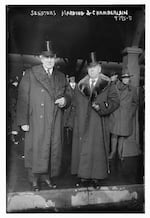
Sens. Warren G. Harding, left, and George E. Chamberlain in New York in January 1919.
Library of Congress, Prints & Photographs Division, LC-B2- 4795-5 [P&P]
Oregon wasn’t caught flat-footed, though. There was a backup plan for cases such as these. At the time, the common practice was for the governor’s personal secretary to fill in when the head of state was temporarily indisposed — whether because of illness, travel or, in this case, a combination of both.
So with a hole to fill between Chamberlain’s resignation and when Benson was to be sworn in, Oregon needed an acting governor. The person in a position to serve that role just happened to be the outgoing Oregon governor's 32-year-old secretary.
“When the Governor goes to Washington he will leave the new private secretary, Mrs. C.B. Shelton, in charge of the affairs of his office,” declared The Morning Oregonian on Feb. 12, 1909.
Reaction to the news was mostly muted. But a surviving Eugene Register editorial offers a glimpse at some of the criticism of the news.
“Until Chamberlain is sworn in as United States Senator, a woman, Mrs. Shelton, will be Oregon's Governess. With addition of a wet nurse, Oregon's juvenile political condition ought to be in a fair way for receptive knowledge of what constitutes commonplace government."
At 9:15 a.m. on the morning of Saturday, Feb. 27, 1909, Shelton assumed the role of the acting governor — becoming the nation’s first female governor in the process. For a weekend, a woman who couldn’t legally cast a ballot possessed the power to issue pardons, veto bills and sign executive orders.
By 10:10 a.m. the following Monday, her time in office was over. Benson was formally sworn in as governor.
"Has Three Governors In Three Days," the front page of The Daily Capital Journal declared on March 1, 1909. "Oregon Holds The World's Record For Changing Rulers. Secretary of State Benson is today the third governor that Oregon has had in the last three days."
———
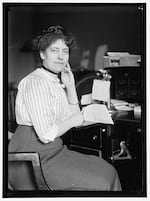
One of the reasons documentation of Carrie B. Shelton's story remains elusive stems from the various spellings of her name throughout archives and collections. This photo from the Library of Congress of Shelton from 1914 lists her as "Miss Carolyn B. Sheldon." In reality, her name is Carrie Bertha Shelton.
Library of Congress, LC-H261- 3700 [P&P]
For 48 hours and 55 minutes, Carrie Shelton was the acting head of Oregon's government, yet she is not mentioned on lists of historical women in America.
Shelton's story may not have made it to the history books, but we still know it happened. That's thanks in large part to the work of a handful of historians and writers, such as Finn J.D. John. The Oregon State University new media communications professor is the man behind the Offbeat Oregon History column and podcast. His 2011 story on Shelton appears to be the first major accounting of her historical prominence in nearly 100 years.
In 2015, Kaylyn F. Mabey with the Willamette Heritage Center offered another picture of America's first female governor. Her exhaustive research dug up more about Shelton's life before Salem. Mabey also tracked down some of the best historical documentation of Shelton that still exists, ensuring its preservation for years to come.
Then there's Kimberly Jensen. The professor of history and gender studies at Western Oregon University has written extensively about Shelton on her blog. An expert on other historical women from Oregon's past, Jensen spent considerable time digging through historical records and newspaper archives to recreate Shelton's story. Using those documents, Jensen helped put Shelton's story — or the lack thereof — into historical context.
“Her case is a very powerful case of someone who was very significant, who was the first — someone that we should know about and yet it takes a lot of digging to find her,” Jensen said.
———
The fact that Carrie Shelton’s story is not more well-known doesn’t shock many historians.
“It's very clear that the documentation that existed once doesn't exist for many women,” Jensen said. “But also the public record … there's a lot of erasure.”
Erasure is a historical concept often described as the removal of written material or recordings from the record — like former Soviet Union leader Joseph Stalin removing people from photographs. Historians note it also includes a failure to document certain events or persons in their time.
“We live in a world that has long been structured to a certain and significant extent by ideas of white supremacy and patriarchy,” said Oregon Historical Quarterly editor Eliza E. Canty-Jones. “I think that infects a lot of what we know about the past.”
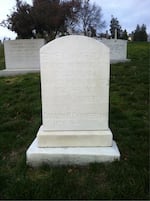
Carrie B. Chamberlain's first name was spelled as Caralyn in her obituary in 1936 — a spelling repeated on her gravestone at the Arlington National Cemetery. According to Shelton's great-great niece, Anne Mitchell, Caralyn was the name she went by when she began working for George Chamberlain. Newspapers often went with the more common spelling of Carolyn when writing about her, though her name was actually Carrie.
Arlington National Cemetery/U.S. Army
For women in the 18th and 19th centuries, that results in stories ignored or purposely not documented.
“One of the biggest, most glaring examples I think that we see all the time are just names,” Canty-Jones said. “When you look at newspapers, a lot of time from these earlier time periods, women who are married are named simply as 'Mrs. their husband's names.'” That can make it difficult to even find their stories, Canty-Jones said.
This happened to Carrie Bertha Shelton in glaring ways.
Take her obituary as an example. Published in the Oregon Statesman on Feb. 4, 1936, it ignores her own political accomplishments in favor of those of her late husband. In another wrinkle to her story, Shelton later married her longtime boss and mentor, George Chamberlain, in 1926 in Norfolk, Virginia, making them the first and only pair of former governors in U.S. history to wed.
“Mrs. George E. Chamberlain, 58, widow of the late Senator George Chamberlain who also served two terms as governor of Oregon, died at the Royal Court apartments here last night after a week’s illness,” the article began.
According to her death certificate, Caralyn B. Chamberlain (as her name was written on the document) was 59 when she died, not 58. The obituary used the spelling repeated on her gravestone at the Arlington National Cemetery. According to Anne Mitchell, a great-great-niece of Carrie's who contacted OPB a few weeks after this story was published, Carrie began to go by Caralyn when she started working for George Chamberlain following her first husband's death.

Anne Mitchell is the great-great niece of Carrie Shelton, America's first female governor. She has spent countless hours tracking down documents about her family's past and is in possession of many of Shelton's surviving possessions.
Bryan M. Vance / OPB
"Our family has several Carries," she said of the spelling. "She was always Carrie until she had worked for Mr. Chamberlain for a few years and he wanted formality, so she became Caralyn."
But newspapers often went with the more common spelling of Carolyn when writing about her.
America’s first female governor went down in history as a secretary to her late husband.
“I think we need to see these are conscious decisions about whose stories get to be told,” Jensen said. “This is a story of someone who was a person of privilege, who married a former governor and U.S. senator, who was white and well educated — a person of privilege in the early 20th century. So if you can imagine the ways in which people who did not have such privilege their lives are also very invisible to us in many ways.”
———
Before her career in politics, Carrie Shelton was a child on the frontiers of Oregon. Born into a prominent Union County family on Oct. 3, 1876, as Carrie B. Skiff, she was the fourth of Willis and Mary Skiff’s six children.
By all accounts, Carrie Shelton's childhood was a comfortable one. Carolyn's father, Willis, was a former Union County and Union city official who transitioned to a successful life in business.
Carrie's life changed on July 24, 1886 — the night her father disappeared. Willis, on a business trip to North Powder, Oregon, was last seen sitting on the veranda of the town's hotel, awaiting the midnight train that was to return him home. When he never arrived, his disappearance sparked an intense investigation. The case remains unsolved to this day.
Carrie's mother, Mary, died within two years. Now orphans, Carrie and two of her siblings went to live with their older brother Orin and his wife. But on Sept. 23, 1889, Carolyn, then 12, and her little sister Mabel became wards of former Union County Judge John W. Shelton, a leader in the effort to solve the mystery of their father's disappearance.
In 1892, with his wife, Delilah, away visiting family in California, John Shelton obtained a divorce — which was later overuled by a judge — before heading off to Weiser, Idaho, with Carrie in tow. There they were married on Oct. 27, 1892, two weeks after her 16th birthday. But the questionable marriage was short-lived. Less than two years later, she was a widow.
———
The widowed teenager started her career as a stenographer at the Portland law firm of Chamberlain and Thomas in 1895. There she fell under the tutelage of a powerful attorney and former politician, George Chamberlain, who drastically changed the course of her life.
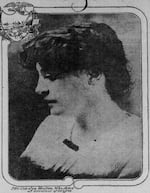
A portrait of Carrie B. Shelton published along with a profile of her in the Jan. 11, 1914, edition of The Sunday Oregonian.
The Sunday Oregonian/Oregonian
Carrie Shelton was a quick learner with an unparalleled work ethic.
"To enter a man's business world untried and without any previous training, at an age when a youth would not have yet reached his majority, and to have accomplished all she has, would be an achievement of which any man of middle age might be proud," The Sunday Oregonian proclaimed of her resume in a 1914 profile.
Chamberlain noticed her talent early on and took her under his wing, giving her responsibilities not usually afforded to stenographers.
“In the law office she was as useful as a young lawyer would have been in preparing papers and looking after office business,” Chamberlain told The Morning Oregonian in 1909.
"I believe that if one has a natural aptitude for the technical terms of law the study of it becomes comparatively easy," Shelton told The Sunday Oregonian in 1914. "That I was able to grasp the subject was proven by the fact that later on I was allowed to draw many of the legal papers prepared in the office, such as deeds, mortgages, confirmations of sales and others work which is usually intrusted [sic] to a young lawyer."
When Chamberlain was elected to the Multnomah County district attorney’s office in 1900, he took his sharp-minded stenographer with him. There she filled out her legal knowledge with lessons on criminal law by helping draft indictments.
At just 25 years old, Shelton joined Chamberlain in Salem two years later when he was elected governor.
At some point during Chamberlain’s two tenures in the governor’s office, Shelton was promoted from stenographer to personal secretary. And with Chamberlain’s election to represent Oregon in the U.S. Senate in 1909, Shelton’s ascent to the governor’s desk was in motion.
———
Carrie Shelton may be a victim of her own competence. Her story would be better documented had she bungled her time in office. But for those nearly 49 hours she served as acting governor, Oregon continued on with business as usual.
“I think it's worth asking the question,” Canty-Jones said, “‘How significant was the few days that she spent as acting governor really?’”
John echoes that point.
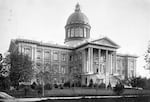
The Oregon State Capitol building of 1876. Carrie B. Shelton served as acting governor of Oregon from this building for roughly 49 hours in 1909. The building was destroyed by a fire on the night of April 25, 1935.
Oregon Historical Society, 62727
There’s not much documentation on anything related to Shelton’s time in office — that includes successes. Noticeably, we’re also missing detailed reflection from Shelton herself on her career and her brief moment in office.
According to Mitchell, Carrie never kept a journal to pass down. Most of what the family knows about Carrie Shelton's life is courtesy of family stories, some of Carrie's personal possessions and writings to and from other members of the family during Carrie's life. Mitchell is also an avid genealogist who has spent years tracking down a treasure trove of documents to verify the details of her great-great aunt's life.
Despite Mitchell's work, though, we still don’t know what Shelton's specific duties in the governor’s office were. We don’t know what decisions she made. More importantly, we don’t know what her time in office was like for her. We don’t know how she felt about her role.

Anne Mitchell points to a never-before-published photo of Carrie Shelton. The great-great niece of Shelton, Mitchell is currently in possession of many of the former acting Oregon governor's surviving possessions.
Bryan M. Vance / OPB
———
Shortly after stepping down as acting governor, Shelton boarded a train bound for Washington, D.C., joining now-Sen. Chamberlain once again as his personal secretary. She oversaw a staff of at least three additional clerks, according to official registers of Senate employees from the time. By 1914, she also served in the role of the clerk to the Senate Committee on Military Affairs, of which Chamberlain was the ranking member.
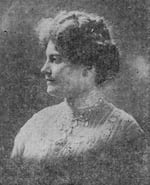
Few photos of Carrie B. Shelton have survived to this day, aside from some grainy black-and-white profile shots which ran in newspapers more than 100 years ago.
The Morning Oregonian/Oregonian
Shelton followed Chamberlain again when he joined the United States Shipping Board in 1921, serving as his personal secretary until he resigned in 1923 and returned to private law in the D.C. area. Shelton continued working alongside Chamberlain through the death of his wife, Sallie, in 1925 and remained beside him when, at age 72, he suffered a paralytic stroke.
On July 12, 1926, Shelton and Chamberlain wed in Norfolk, Virginia. Again, her marriage was short-lived. Left an invalid by the stroke, George Chamberlain fell ill and died on July 9, 1928, three days shy of the couple’s second wedding anniversary.
Carrie Bertha Chamberlain, a widow for the second time, returned home to Oregon. She lived out her remaining years quietly between Union County and Salem. Removed from public life, she died on Feb. 3, 1936, at age 59. The erasure of her story was underway.
So much of Carrie Bertha Shelton’s story is lost to history. But the magnitude of her story wasn’t lost on her.
For Shelton, the most important part of her achievement wasn’t her role, “it was its legal significance,” she said in 1914. “So when the Senator went away for the first time after he had taken his oath of office as Governor of Oregon, I suddenly found that I was, so to speak, in his shoes, and was really ‘Madam Governor.’”

